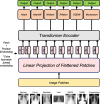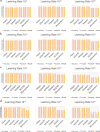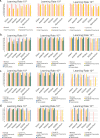Optimization of vision transformer-based detection of lung diseases from chest X-ray images
- PMID: 38978027
- PMCID: PMC11232177
- DOI: 10.1186/s12911-024-02591-3
Optimization of vision transformer-based detection of lung diseases from chest X-ray images
Abstract
Background: Recent advances in Vision Transformer (ViT)-based deep learning have significantly improved the accuracy of lung disease prediction from chest X-ray images. However, limited research exists on comparing the effectiveness of different optimizers for lung disease prediction within ViT models. This study aims to systematically evaluate and compare the performance of various optimization methods for ViT-based models in predicting lung diseases from chest X-ray images.
Methods: This study utilized a chest X-ray image dataset comprising 19,003 images containing both normal cases and six lung diseases: COVID-19, Viral Pneumonia, Bacterial Pneumonia, Middle East Respiratory Syndrome (MERS), Severe Acute Respiratory Syndrome (SARS), and Tuberculosis. Each ViT model (ViT, FastViT, and CrossViT) was individually trained with each optimization method (Adam, AdamW, NAdam, RAdam, SGDW, and Momentum) to assess their performance in lung disease prediction.
Results: When tested with ViT on the dataset with balanced-sample sized classes, RAdam demonstrated superior accuracy compared to other optimizers, achieving 95.87%. In the dataset with imbalanced sample size, FastViT with NAdam achieved the best performance with an accuracy of 97.63%.
Conclusions: We provide comprehensive optimization strategies for developing ViT-based model architectures, which can enhance the performance of these models for lung disease prediction from chest X-ray images.
Keywords: Lung disease; Optimizer; Vision transformer; X-ray.
© 2024. The Author(s).
Conflict of interest statement
The authors declare no competing interests.
Figures



Similar articles
-
LungNet-ViT: Efficient lung disease classification using a multistage vision transformer model from chest radiographs.J Xray Sci Technol. 2025 Jul;33(4):742-759. doi: 10.1177/08953996251320262. Epub 2025 Mar 28. J Xray Sci Technol. 2025. PMID: 40152248
-
IEViT: An enhanced vision transformer architecture for chest X-ray image classification.Comput Methods Programs Biomed. 2022 Nov;226:107141. doi: 10.1016/j.cmpb.2022.107141. Epub 2022 Sep 16. Comput Methods Programs Biomed. 2022. PMID: 36162246
-
Explainable hybrid transformer for multi-classification of lung disease using chest X-rays.Sci Rep. 2025 Feb 24;15(1):6650. doi: 10.1038/s41598-025-90607-x. Sci Rep. 2025. PMID: 39994381 Free PMC article.
-
LDDNet: A Deep Learning Framework for the Diagnosis of Infectious Lung Diseases.Sensors (Basel). 2023 Jan 2;23(1):480. doi: 10.3390/s23010480. Sensors (Basel). 2023. PMID: 36617076 Free PMC article.
-
Deep Learning Applications in Chest Radiography and Computed Tomography: Current State of the Art.J Thorac Imaging. 2019 Mar;34(2):75-85. doi: 10.1097/RTI.0000000000000387. J Thorac Imaging. 2019. PMID: 30802231 Review.
Cited by
-
Automated classification of chest X-rays: a deep learning approach with attention mechanisms.BMC Med Imaging. 2025 Mar 4;25(1):71. doi: 10.1186/s12880-025-01604-5. BMC Med Imaging. 2025. PMID: 40038588 Free PMC article.
-
Metaheuristic optimizers integrated with vision transformer model for severity detection and classification via multimodal COVID-19 images.Sci Rep. 2025 Apr 22;15(1):13941. doi: 10.1038/s41598-025-98593-w. Sci Rep. 2025. PMID: 40263404 Free PMC article.
-
A Deep Convolutional Neural Network Model for Lung Disease Detection Using Chest X-Ray Imaging.Pulm Med. 2025 Jun 24;2025:6614016. doi: 10.1155/pm/6614016. eCollection 2025. Pulm Med. 2025. PMID: 40599379 Free PMC article.
-
A ubiquitous and interoperable deep learning model for automatic detection of pleomorphic gastroesophageal lesions.Sci Rep. 2025 Jul 2;15(1):22889. doi: 10.1038/s41598-025-03397-7. Sci Rep. 2025. PMID: 40594126 Free PMC article.
References
-
- Zhou SK, Greenspan H, Davatzikos C, Duncan JS, Van Ginneken B, Madabhushi A, Prince JL, Rueckert D, Summers RM. A review of deep learning in medical imaging: Imaging traits, technology trends, case studies with progress highlights, and future promises. Proc IEEE. 2021;109(5):820–838. doi: 10.1109/JPROC.2021.3054390. - DOI - PMC - PubMed
-
- Dosovitskiy A, Beyer L, Kolesnikov A, Weissenborn D, Zhai X, Unterthiner T, Dehghani M, Minderer M, Heigold G, Gelly S. An image is worth 16x16 words: Transformers for image recognition at scale. 2020.
MeSH terms
Grants and funding
LinkOut - more resources
Full Text Sources
Medical
Miscellaneous

